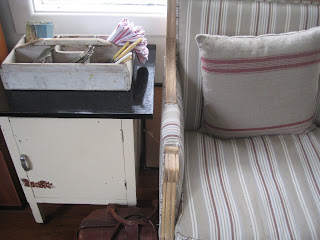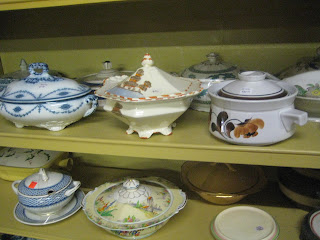I'm eagerly awaiting the arrival of this book by
Rebecca Purcell, formerly of ABC Carpet and Home, and anthropologie catalogues:
I felt like she understands my aesthetic, my ideology. I have just finished writing a PhD thesis which has now been published as a book. It started as an analysis of the role of art in women's fiction. Over the six years it took me to write it, it evolved into a study of materialist culture, of objects such as paintings, curiousity cabinets, kitchen utensils and other still life elements, and the sensual pleasure that these evoke. Today when I was reading Rebecca Purcell's website, I discovered that she also has a love of objects. Her ideology captures the essence of what I tried to achieve in that thesis and what, I have since discovered, shapes my world view.
In her essay called "MODERNOSTALGIA: an Exploration Into the World of Aesthetics", Rebecca says:
"I have always enjoyed the art of personal style, but I never really liked the rat race of trying to look like I had money. Not that you have to have money to have style but the two are often linked. In other words, trying to make inexpensive things look wonderful is more enjoyable for me than having the economic means to buy something already fabulous (well, most of the time). Fortunately, there has been a growing community of like-minded individuals who adore items for their intrinsic character rather than striving for upper class sensibilities, or social sanctioning. I of course champion the recent popularity of this trend that favors nostalgic items mixed in an eclectic fashion, most often with a little something macabre or funky thrown in. A look I call modern nostalgic, or “Modernostalgia”. “Modern” refers to that which is unique to our era, a very diverse mix of genres and styles. It can also refer to 20th century design that is, often, a part of the look, like accents from the 50’s, 60’s or 70’s. “Nostalgic” refers to the use of many vintage and antique elements usually arranged in a rather casual manner. Think cabinet of curiosities, think Bobo (bohemian bourgeois), the movie “Amelie” or simply visualize the variety of a flea market turned into a home or a wardrobe."
She goes on to say:
"So, is Modernostalgia, or whatever you want to call it, tacky and/or over? Certainly not in my book! First of all this look is a part of remembering the past and when is that supposed to be over? When do we suddenly decide that we all want to live in a Star Trek environment that bears no reference to the peoples of the past and the things they used and lived with? I am not saying that every one should love the modern nostalgic aesthetic, just that it is really not a thing that can be “dated.” As a reaction to our increasingly technological world some of us really need a few old, battered bits around. Nostalgia is only a bad thing when it replaces an interest in what is new, with a misguided desire for an over idealized past that never existed. Second, the “weathered look” so associated with a modern nostalgic aesthetic, is part of reality. Weather happens. During the process of participating in life, every object becomes worn in some respect either from handling or environmental conditions. So an older table, darkened by wax, oils and spills, marked with scuffs and dings, referred to by some as having a nostalgic, even sentimental “look”, is simply a table that has participated in life. Yes, some designers actually imitate this effect, just as some create the effect of looking pristine and not weathered."

It's lovely when you find someone who is able to articulate the way you feel, isn't it?
Image from 'Interior Alchemy' book found on
this site.





























